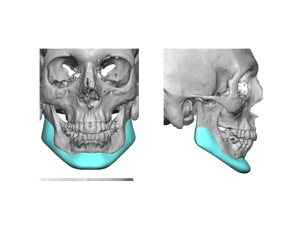Background: The bony anatomy of the mandible (jawline) is highly responsible for the shape of the lower face. This is well demonstrated by historic augmentation procedures (chin and jaw angle implants) and more recent aesthetic jawline reduction procedures. (V-line jaw reshaping) Both jawline augmentation and reduction procedures have their challenges but jawline augmentation procedures are technically easier to perform as well as to reverse.
V-line jaw reshaping has become a very popular aesthetic procedure that is most commonly performed in Asian patients. It typically consists of intraoral osteotomies with bone resection of the chin as well as jaw angle reduction by ostectomy or burring. It is an effective way to reduce wide jaw angles, narrow the chin and create a better jawline taper. But despite its general success, aesthetic complications can ensue with its execution including over resection of the jawline, jawline asymmetry, soft tissue sagging and an overall unhappiness with the change and a desire to reverse it.
Reversing V-line jaw reshaping or reconstruction of it requires a bony augmentation of what has been previously removed. In some cases this may be done by standard shaped chin and jaw angle implants. But in most cases this is best done by making a custom implant to rebuild the jawline all the way around from one jaw angle to the other wrapping around the chin for a complete connection.

Under general anesthesia and through a three-incisional intraoral approach, the custom jawline implant was placed through subperiosteal pocket developments. Care was taken to ensure these pockets were made below the mental nerves on each side to prevent injury to them. Small titanium screw fixation was used in a triangulation fashion over the chin and jaw angle sections of the implants.
His results showed the creation of a more defined jawline that presumably was close to what he had prior to V-line jaw reshaping. A postoperative 3D CT scan comfirmed the placement and good symmetry of the custom jawline implant.
Highlights:
1) V-line jaw reshaping surgery results in predictable loss of mandibular with risks of over resection, loss of soft tissue support or aesthetic unhappiness.
2) Reconstruction of V-line jaw reshaping changes is best done with a custom wrap around jawline implant.
3) Proper analysis of the jawline after prior surgery requires a 3 D CT scan for both accurate assessment and design of a custom jawline implant.
Dr. Barry Eppley
Indianapolis, Indiana


